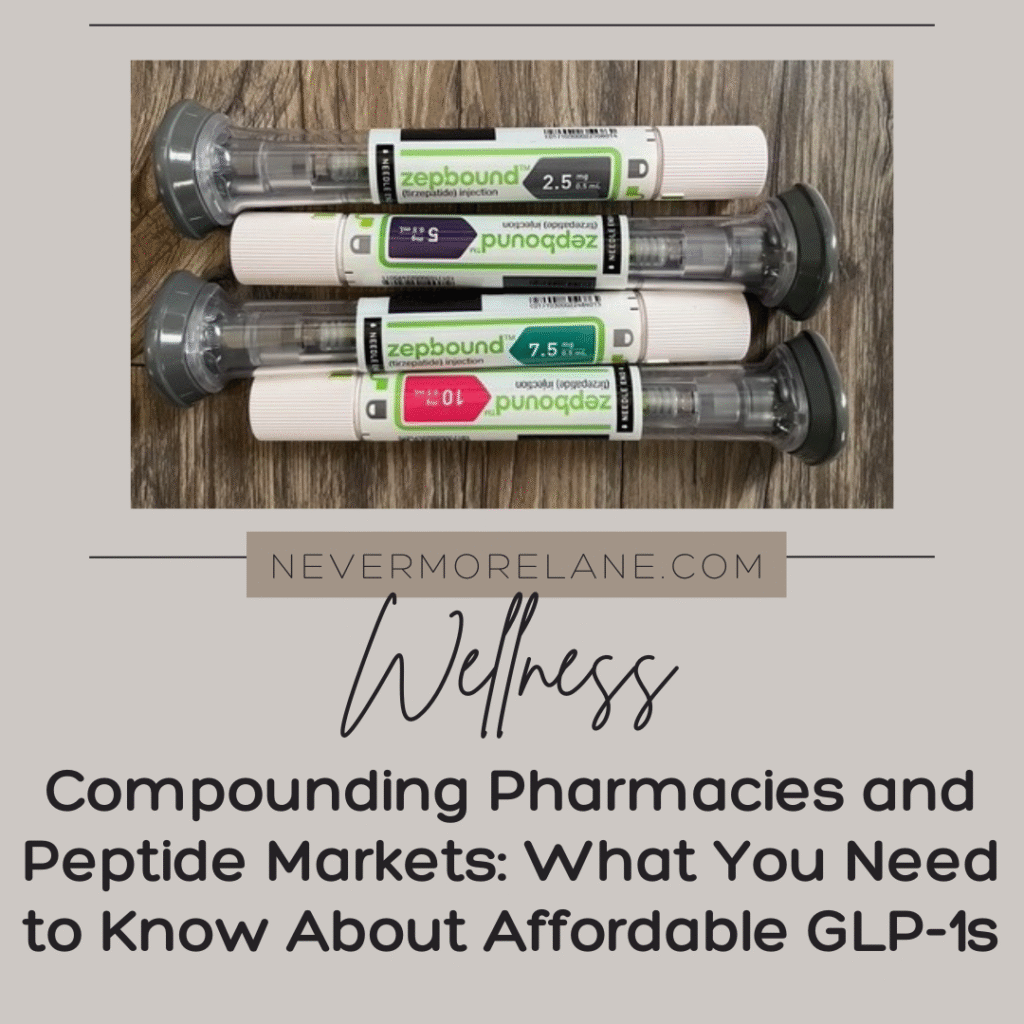Compounding Pharmacies and Peptide Markets: What You Need to Know About Affordable GLP-1s
You’re scrolling through social media when you see yet another post about someone’s weight loss success with semaglutide. The before and after photos are inspiring, but it’s the comment section that catches your attention. People are talking about prices you’ve never seen before: $250 per month instead of $1,200. Compounding pharmacies. Peptide suppliers. Research chemicals. Terms you’ve never encountered in your previous pharmacy experiences. Some commenters swear by these alternatives, sharing their sources and singing praises. Others warn about risks and quality concerns. You’re intrigued by the possibility of affordable access to a medication that could change your life, but you’re also overwhelmed by information you don’t fully understand.
The landscape of GLP-1 medication access has transformed dramatically in recent years. What was once a straightforward transaction between doctor, insurance company, and pharmacy has fractured into multiple pathways, each with its own rules, risks, and benefits. Compounding pharmacies and peptide markets have emerged as significant alternatives for people seeking affordable semaglutide and tirzepatide, but navigating these options requires knowledge that most people simply don’t have. The terminology is confusing, the regulatory framework is complex, and the stakes are high because we’re talking about substances you’ll be injecting into your body. Making uninformed decisions in this space can lead to wasted money, ineffective treatment, or genuine health risks.
This post exists to demystify compounding pharmacies and peptide markets so you can make truly informed decisions about your GLP-1 access. We’ll break down exactly what these alternatives are, how they differ from each other and from traditional pharmacies, what safety considerations matter most, how to identify reputable sources, and what questions you should be asking before purchasing from either option. Whether you’re considering these alternatives because of cost, insurance denials, or simple curiosity, you deserve clear, honest information that empowers you to choose wisely. Let’s cut through the confusion and get to the facts you actually need to know.
Understanding Compounding Pharmacies: The Basics
Compounding pharmacies are licensed pharmacies that create customized medications by combining, mixing, or altering ingredients to meet specific patient needs. This practice has existed for centuries and remains a legitimate, regulated part of the pharmacy profession. Unlike retail pharmacies that dispense manufacturer prepared medications in standard doses and forms, compounding pharmacies can create unique formulations tailored to individual requirements. Common uses include adjusting medication strengths, removing allergens or inactive ingredients that cause reactions, combining multiple medications into a single dose, or creating alternative delivery methods like topical creams instead of pills.
The legal framework for compounding is well established under both federal and state regulations. The FDA oversees compounding through two primary pathways under the Drug Quality and Security Act. Section 503A covers traditional compounding pharmacies that prepare medications based on individual patient prescriptions for specific medical needs. Section 503B covers outsourcing facilities that can produce larger batches of compounded medications without individual patient prescriptions. Both types must register with the FDA and comply with quality standards, though 503B facilities face more stringent requirements similar to drug manufacturers. State boards of pharmacy provide additional oversight, licensing, and regulation of compounding pharmacies within their jurisdictions.
For GLP-1 medications specifically, compounding has become more accessible due to FDA acknowledged drug shortages. When the FDA adds a medication to its drug shortage list, it creates legal space for compounding pharmacies to produce that medication without violating exclusivity or patent restrictions. Both semaglutide and tirzepatide have appeared on shortage lists, opening the door for compounding pharmacies to offer these medications at significantly reduced costs. A compounded version might cost $200 to $400 per month compared to $900 to $1,400 for brand name versions. The active ingredient is the same pharmaceutical compound found in Wegovy, Ozempic, or Mounjaro, but it’s prepared by the pharmacy rather than the original manufacturer. The medication still requires a valid prescription from a licensed healthcare provider, and reputable compounding pharmacies will verify your prescription before dispensing.
The Peptide Market: A Different Animal
The peptide market operates in a fundamentally different space from compounding pharmacies. Peptide suppliers typically sell research chemicals labeled “not for human consumption” to navigate FDA regulations, even though many buyers intend to use them personally. These companies source raw peptide compounds, often imported from overseas manufacturers, and sell them to consumers directly without requiring prescriptions. The products come in various forms, most commonly as lyophilized powder that requires reconstitution with bacteriostatic water before injection. Pricing can be remarkably low compared to pharmacy obtained medications, sometimes as little as $100 to $250 for a monthly supply.
The regulatory status of the peptide market exists in murky territory. These suppliers aren’t pharmacies and don’t claim to be selling medications for human use, which allows them to operate outside the traditional pharmaceutical regulatory framework. However, the reality that most buyers are using these products for personal health purposes creates legal and ethical gray areas. The FDA has issued warning letters to some peptide suppliers, particularly those making medical claims or clearly marketing products for human consumption despite disclaimers. The enforcement landscape remains inconsistent, with some companies operating openly for years while others face sudden shutdowns. This regulatory uncertainty means buyers assume significantly more risk compared to working with licensed pharmacies.
Quality control represents the most critical difference between peptide markets and pharmacy obtained medications. Compounding pharmacies must follow United States Pharmacopeia standards, maintain sterile compounding environments, implement quality assurance procedures, and face regular inspections. Peptide suppliers face no such mandatory requirements. While some suppliers voluntarily implement rigorous testing and provide certificates of analysis from independent laboratories, others operate with minimal quality oversight. The purity of peptides can vary dramatically, from 95 percent to over 99 percent, with lower purity meaning more impurities and potential contaminants. Some products may be underdosed, delivering less active ingredient than claimed. Others might be entirely different compounds than advertised. Without mandatory testing and enforcement, buyers must rely entirely on the supplier’s integrity and voluntary quality measures, which requires extensive research and carries inherent risks.
Identifying Reputable Compounding Pharmacies
Finding a trustworthy compounding pharmacy requires due diligence and verification of credentials. Start with accreditation status from the Pharmacy Compounding Accreditation Board, which represents the gold standard for compounding quality. PCAB accreditation is voluntary but demonstrates that a pharmacy has undergone rigorous evaluation of its facilities, procedures, personnel, and quality systems. You can verify accreditation status on the PCAB website. Additionally, confirm that the pharmacy is licensed in your state by checking with your state board of pharmacy. Some states have stricter compounding regulations than others, and working with a pharmacy licensed in a state with robust oversight provides additional assurance.
Ask detailed questions about the pharmacy’s sourcing and testing procedures. Where do they obtain their active pharmaceutical ingredients? Reputable pharmacies source from FDA registered suppliers who provide certificates of analysis confirming identity, purity, and quality. What testing does the pharmacy perform on finished products? Beyond source testing, good compounding pharmacies conduct their own verification testing, potency testing, and sterility testing for injectable medications. How do they ensure sterility for compounded injectables? Look for pharmacies with ISO classified clean rooms, proper environmental monitoring, and documented cleaning and maintenance procedures. Don’t hesitate to request information about their quality assurance processes. Legitimate, reputable pharmacies will be transparent and willing to provide documentation.
Pay attention to the overall professionalism and communication from the pharmacy. Do they require a valid prescription from a licensed provider before dispensing medication? If a pharmacy is willing to sell you GLP-1 medications without verifying your prescription, that’s a major red flag indicating they may not be following legal or ethical standards. Do they provide clear instructions for storage, handling, and administration? Proper compounding pharmacies treat their products as the medications they are, with appropriate guidance and support. Is customer service responsive and knowledgeable when you have questions? You should feel confident that you’re working with trained pharmacy professionals, not just a website taking orders. Check online reviews and experiences from other customers, but recognize that individual testimonials aren’t substitutes for proper verification of credentials and quality standards.
Vetting Peptide Suppliers: What to Look For and What to Avoid
If you’re considering purchasing from peptide suppliers, the vetting process becomes even more critical because of the lack of regulatory oversight. Start by researching the supplier’s reputation within the community of users. Online forums, Reddit communities, and social media groups dedicated to peptides often discuss various suppliers, sharing experiences with quality, customer service, and reliability. While anecdotal reports should be taken with healthy skepticism, patterns of consistent positive or negative feedback can provide useful signals. Look for suppliers that have been operating for extended periods with track records of satisfied customers rather than new companies without established reputations.
Certificates of analysis are non-negotiable when evaluating peptide suppliers. A COA is a document from an independent laboratory that tests a specific batch of product and reports on purity, identity verification, and contaminant screening. Reputable suppliers provide COAs for every batch they sell, typically accessible on their website or provided upon request. Examine the COA carefully. It should come from a recognized independent laboratory, not in house testing. The purity level should be clearly stated, ideally 98 percent or higher for pharmaceutical applications. The testing should include identity verification using methods like mass spectrometry or HPLC to confirm the product is actually what it claims to be. Look for endotoxin testing on injectable products to ensure bacterial contamination isn’t present. If a supplier doesn’t provide COAs, refuses to share them, or provides documents that look suspicious or incomplete, eliminate them from consideration immediately.
Red flags should trigger immediate caution or complete avoidance. Suppliers making medical claims, promising specific health outcomes, or explicitly marketing for human consumption despite “not for human use” labels may be operating illegally and attracting unwanted regulatory attention that could disrupt your supply. Prices dramatically lower than competitors might indicate underdosed products, poor quality, or outright scams. Payment methods that seem unusual or sketchy, such as requiring cryptocurrency or wire transfers with no option for credit card payment, suggest the supplier may be trying to avoid traceability. Poor website design, unprofessional communication, lack of contact information, or evasiveness about sourcing and testing should all raise concerns. Customer service that seems knowledgeable about reconstitution, dosing, and safe injection practices suggests the supplier understands their products are being used by humans, which can be reassuring, but customer service that encourages reckless practices or dismisses safety concerns is extremely problematic.
The Practical Realities: Cost, Convenience, and Responsibility
Let’s talk honestly about the practical aspects of using compounding pharmacies versus peptide markets compared to traditional pharmacy routes. Compounding pharmacies typically offer the best middle ground between affordability and safety assurance. You’ll pay significantly less than brand name medications while still working within the regulated pharmacy system with quality standards and professional oversight. Most compounding pharmacies that focus on weight loss medications have streamlined their processes to be relatively convenient. Many work with telemedicine providers who can prescribe, coordinate with the pharmacy, and handle the entire transaction remotely. Your medication arrives at your door in ready to use form, properly dosed and labeled with clear instructions. The experience closely resembles working with any mail order pharmacy, just at a fraction of the cost.
Peptide markets offer the lowest prices but require taking on substantially more personal responsibility. You’ll likely receive lyophilized powder that needs reconstitution with bacteriostatic water before use. This means you need to learn proper technique for mixing the powder and water in correct ratios, understand sterile handling procedures to avoid contamination, calculate your doses accurately based on concentration, and store both the powder and reconstituted solution properly. You’re essentially acting as your own pharmacy technician. Additionally, you’ll need to source your own injection supplies like syringes, needles, alcohol swabs, and sharps containers since peptide suppliers often don’t provide these items. The learning curve is real, and mistakes in reconstitution or dosing can result in ineffective treatment or potential harm. If you’re not comfortable with this level of hands on involvement, peptide markets probably aren’t the right choice for you regardless of cost savings.
Both alternatives require you to be more proactive about medical monitoring than you might be with traditional pharmacy medications. Because you’re working outside conventional insurance and pharmacy systems, your healthcare provider may not have automatic records of your prescriptions and refills. You need to take responsibility for scheduling follow up appointments, getting appropriate lab work to monitor your response and watch for complications, tracking your progress carefully, and maintaining open communication with your provider about your treatment. Some people find healthcare providers unwilling to monitor patients using compounded medications or peptides, which means you may need to seek out providers specifically experienced with or open to these alternatives. This adds another layer of complexity and potentially additional cost for appointments and testing. The money you save on medication might be partially offset by paying out of pocket for provider visits if insurance won’t cover care related to non covered medications.
Making Your Decision with Eyes Wide Open
Choosing between traditional pharmacies, compounding pharmacies, and peptide markets isn’t a simple calculation of which option costs least. It’s a complex decision involving multiple factors including cost, convenience, safety assurance, personal capability, risk tolerance, and access to medical oversight. Traditional brand name medications through insurance remain the gold standard when available and affordable, offering FDA approved products with guaranteed quality, professional dispensing, and typically integrated medical care. But for many people, this option simply isn’t accessible due to cost or insurance denial, making alternatives necessary rather than merely preferable.
Compounding pharmacies represent a reasonable middle path for most people seeking affordable GLP-1 access. You maintain professional pharmacy oversight, quality standards, regulatory protections, and convenient ready to use medication while achieving significant cost savings. The key is doing your homework to identify truly reputable compounding pharmacies rather than assuming all are equally trustworthy. Spend time verifying credentials, asking questions, checking reviews, and ensuring you’re comfortable with the pharmacy before committing. Don’t rush this decision based solely on price comparisons. The cheapest option isn’t always the best value if quality or reliability is compromised.
Peptide markets may make sense for specific individuals who understand the risks, feel confident in their ability to handle reconstitution and dosing responsibilities, have done extensive research on suppliers and quality verification, and have access to medical monitoring even without traditional prescriptions. This path is not for everyone and should not be entered casually. If you’re considering peptides, be brutally honest with yourself about whether you’re prepared for the additional complexity, capable of navigating the learning curve, and committed to ongoing quality verification with each order. Also consider your contingency plan if your chosen supplier shuts down, changes quality, or becomes unreliable. Diversifying knowledge about multiple suppliers and maintaining relationships with healthcare providers who can help monitor your safety becomes essential insurance against disruption.
Finding Your Path Forward
The emergence of compounding pharmacies and peptide markets has simultaneously expanded access to life changing GLP-1 medications and created new challenges in navigating quality, safety, and informed decision making. These alternatives exist because the traditional pharmaceutical and insurance systems have failed to provide affordable access to medications that can significantly improve health and quality of life for millions of people. While that failure is frustrating and unjust, the silver lining is that alternatives have developed to fill the gap. Your job is to approach these alternatives with clear eyes, doing the necessary research, asking the right questions, and making choices that prioritize your safety alongside affordability.
Remember that the cheapest option that makes you sick, provides ineffective treatment, or puts your health at risk is no bargain at all. Your goal should be finding the most affordable pathway to safe, effective, properly dosed GLP-1 medication with appropriate medical oversight. For most people, that likely means working with reputable compounding pharmacies. For some, carefully vetted peptide suppliers might work. For others, the complexity and risk of alternatives means waiting, saving, or finding other solutions feels more appropriate. There’s no universal right answer, only the right answer for your specific situation based on your resources, capabilities, risk tolerance, and access to medical support.
Whatever path you choose, maintain connection with qualified healthcare providers who can monitor your progress, adjust your treatment, watch for complications, and provide guidance when challenges arise. Weight loss medication isn’t something to undertake completely alone without professional oversight, regardless of where you source the medication itself. Your health is worth protecting, your safety matters, and sustainable success requires more than just access to affordable medication. It requires the knowledge, support, and monitoring to use that medication effectively and safely throughout your journey.
Thank you for taking the time to educate yourself about these complex options. Knowledge truly is power when navigating the modern landscape of GLP-1 access. I hope this information helps you make decisions that serve both your health and your financial wellbeing. For more insights on weight loss, wellness, and finding your way through life’s complicated journeys, explore the other posts here on Nevermore Lane. And whenever you need a listening ear or want to discuss your experiences, join me for coffee. There’s always a comfortable spot at my table and plenty of support to share. You’re not alone in figuring this out, and I’m cheering for you every step of the way.
Like what you read? Drop me a line – let’s chat over virtual coffee.
~ Chrystal





